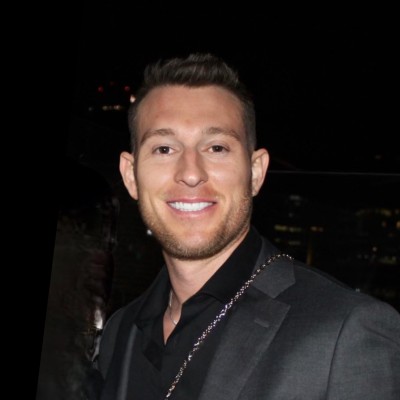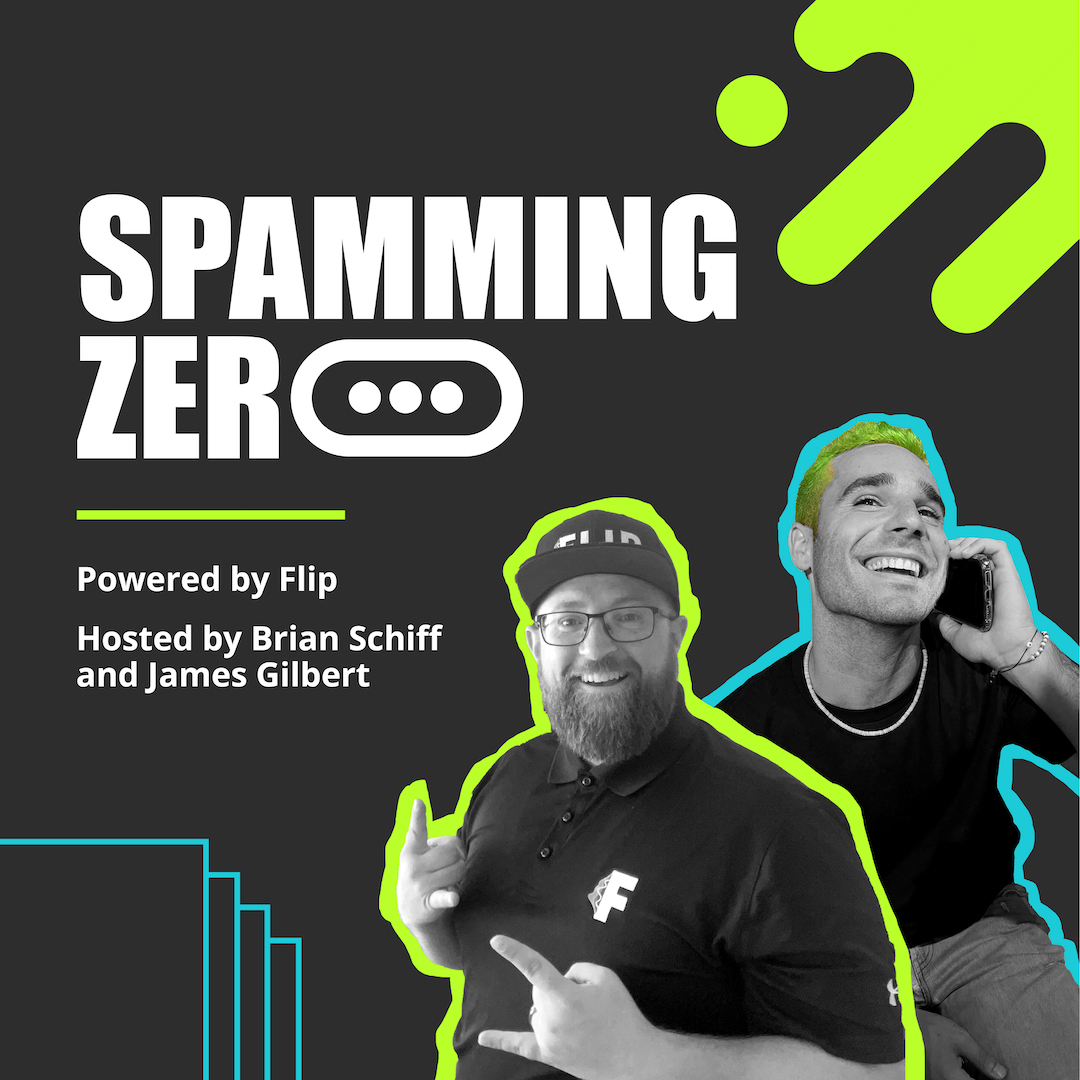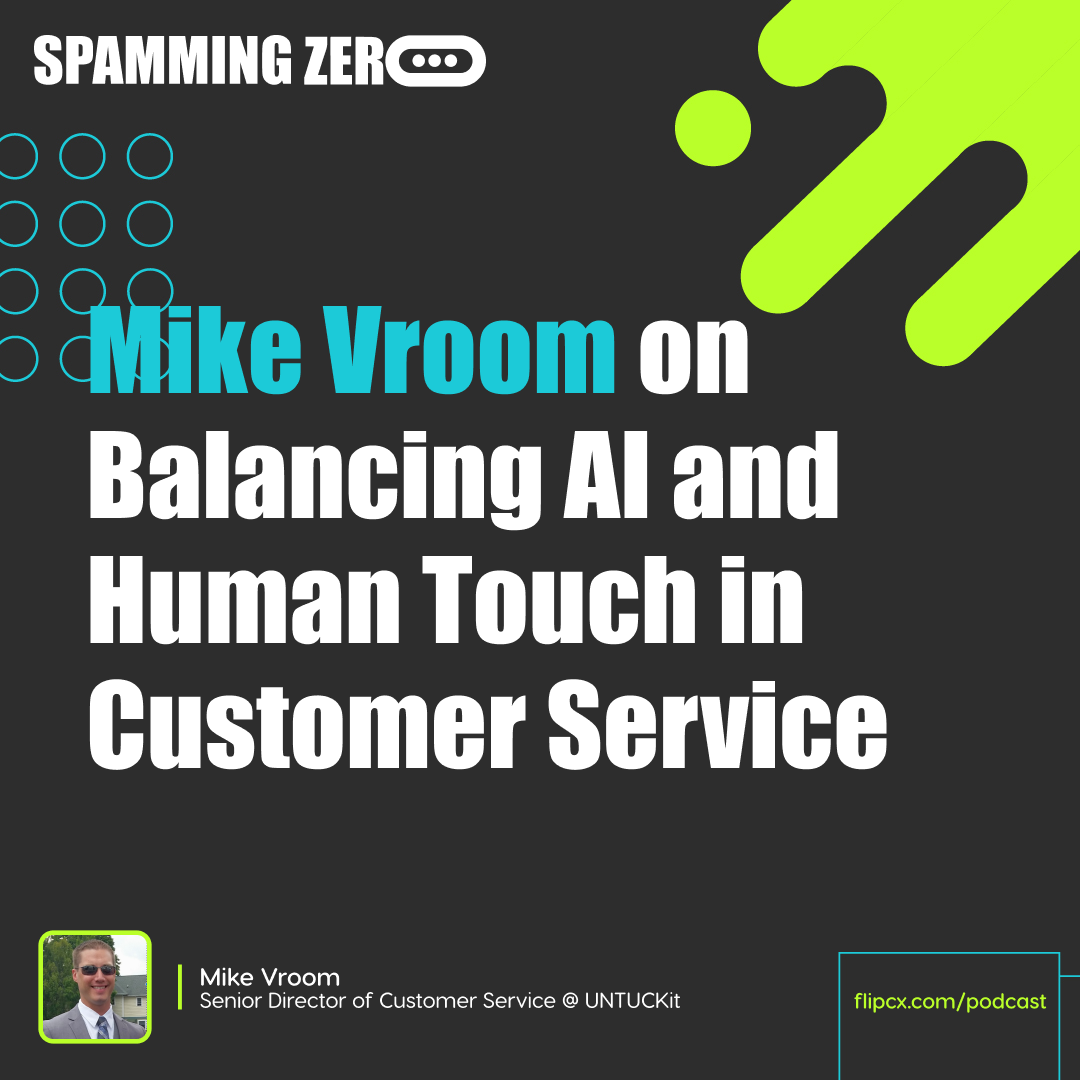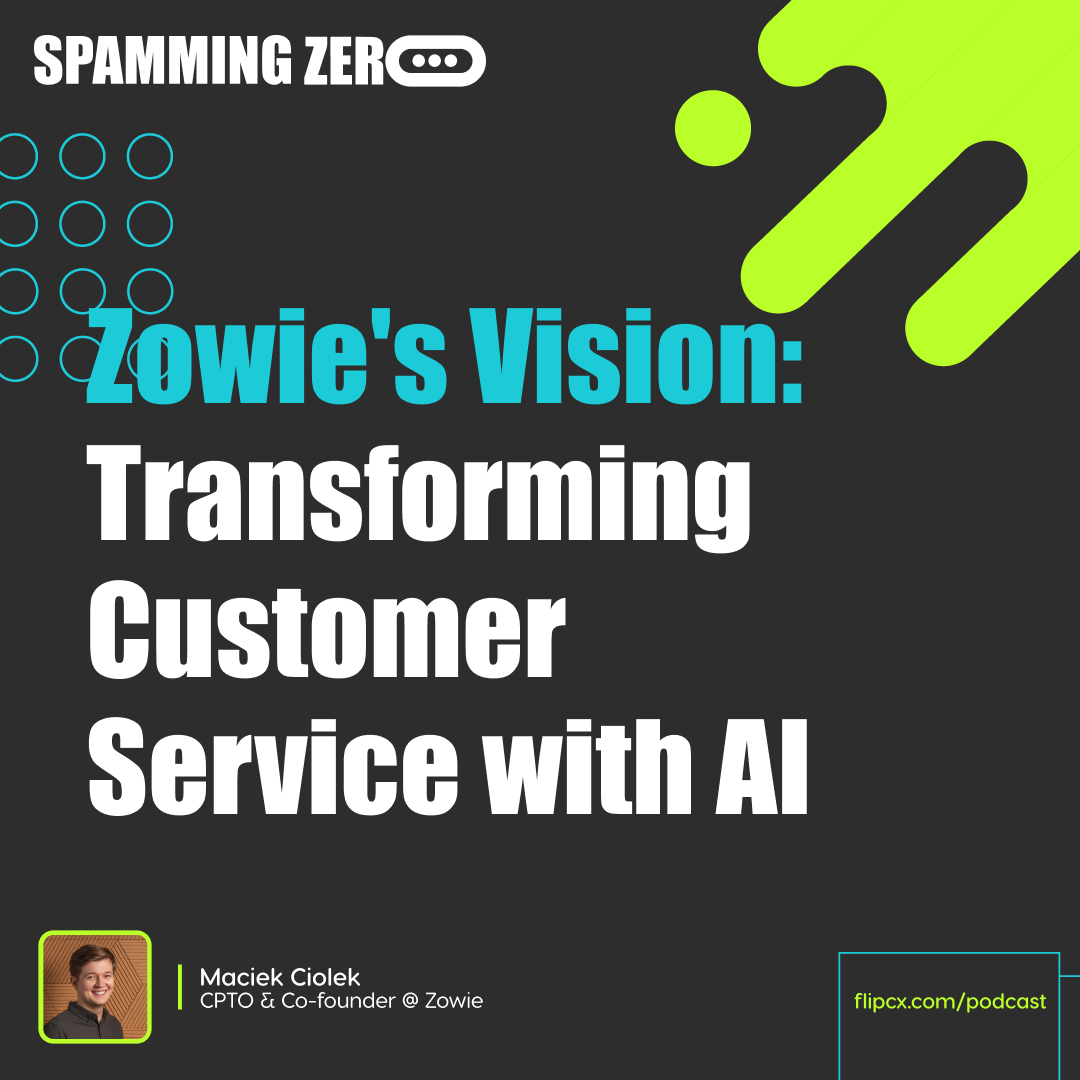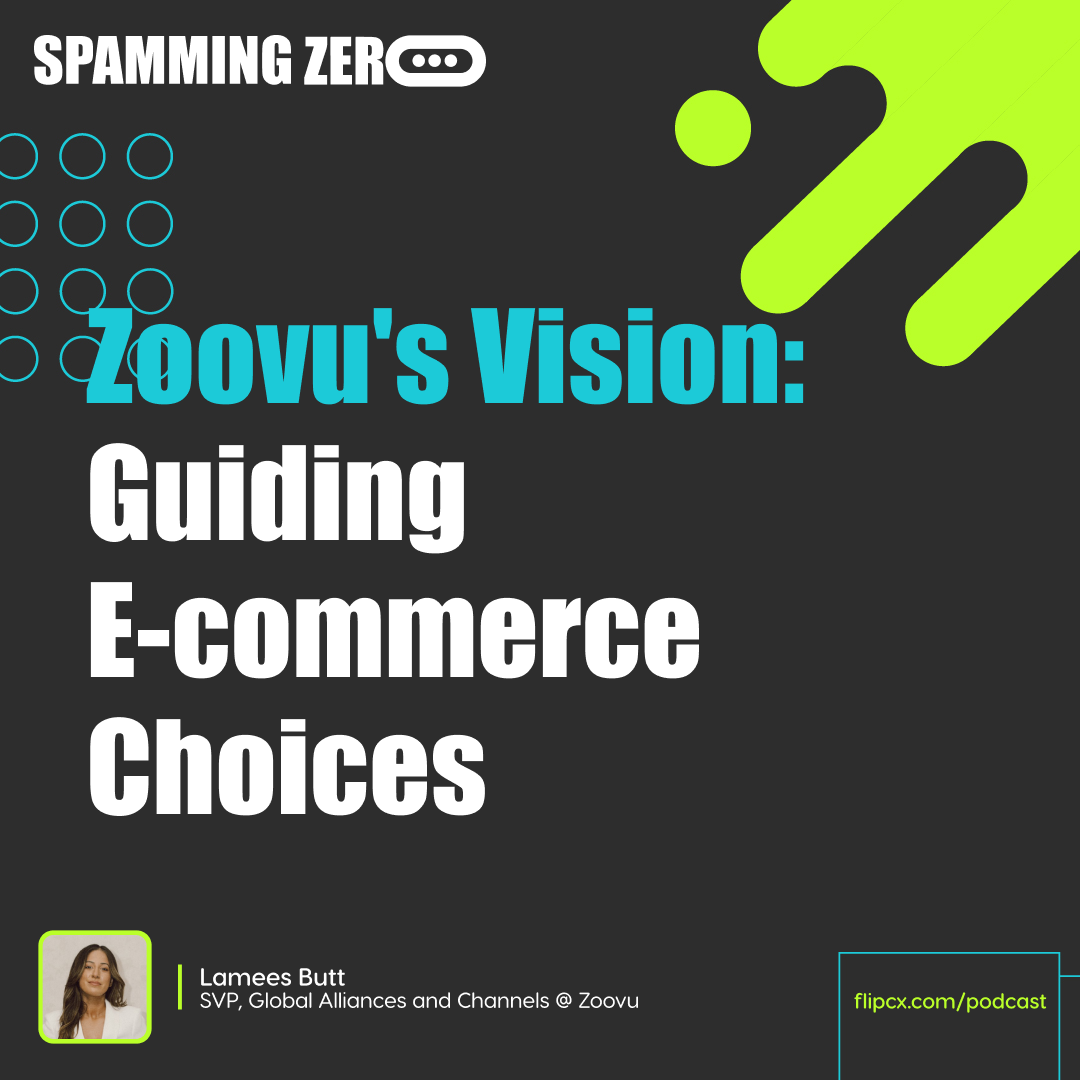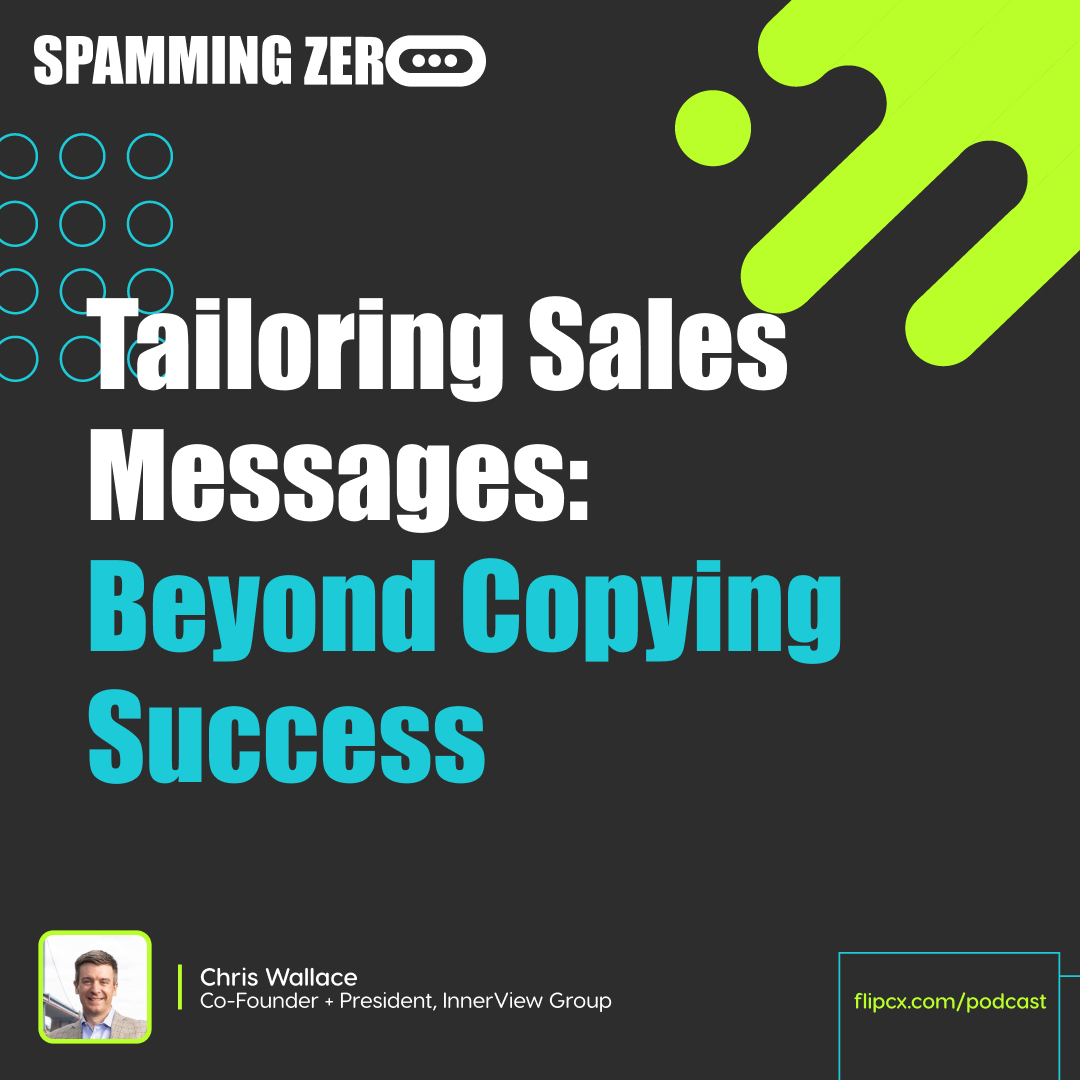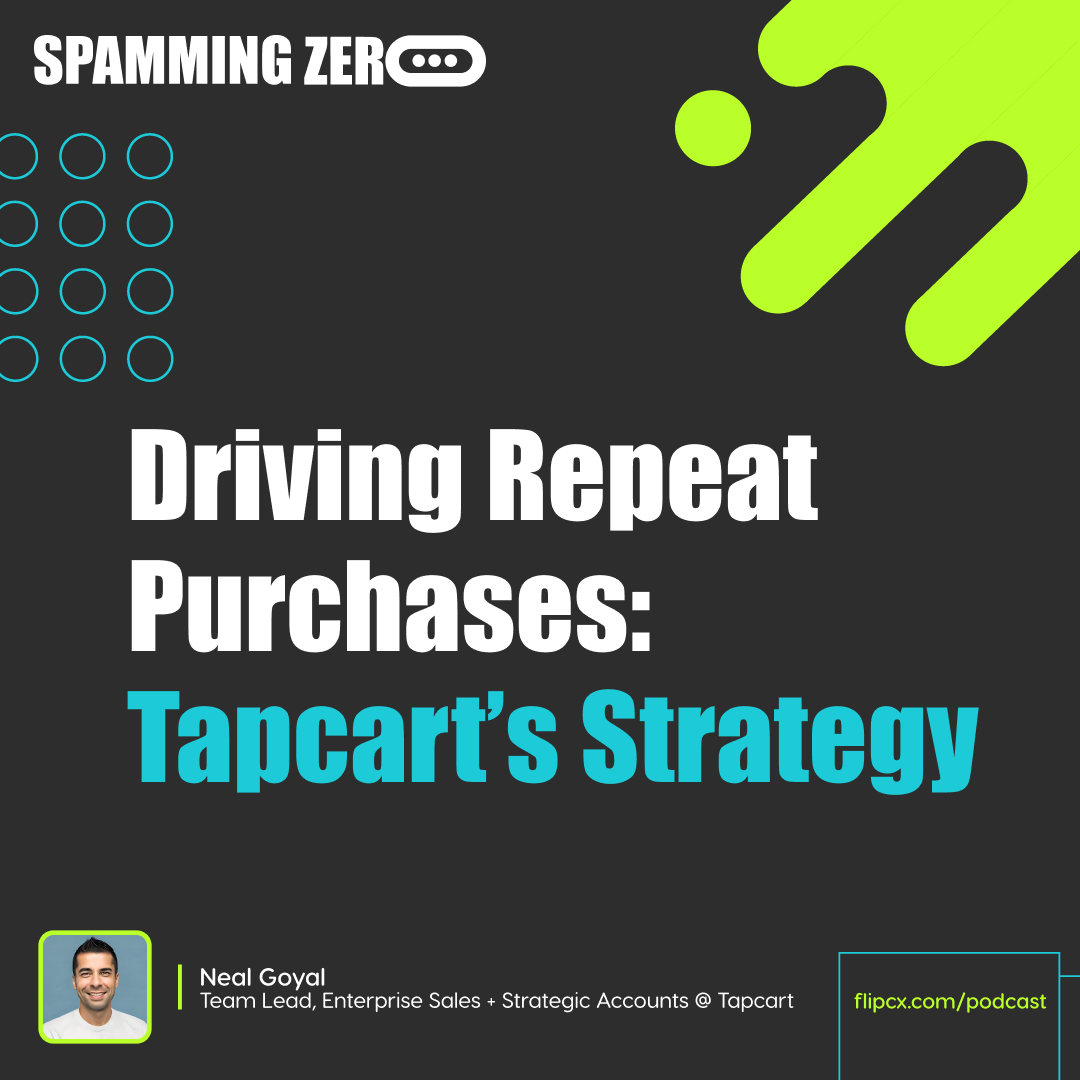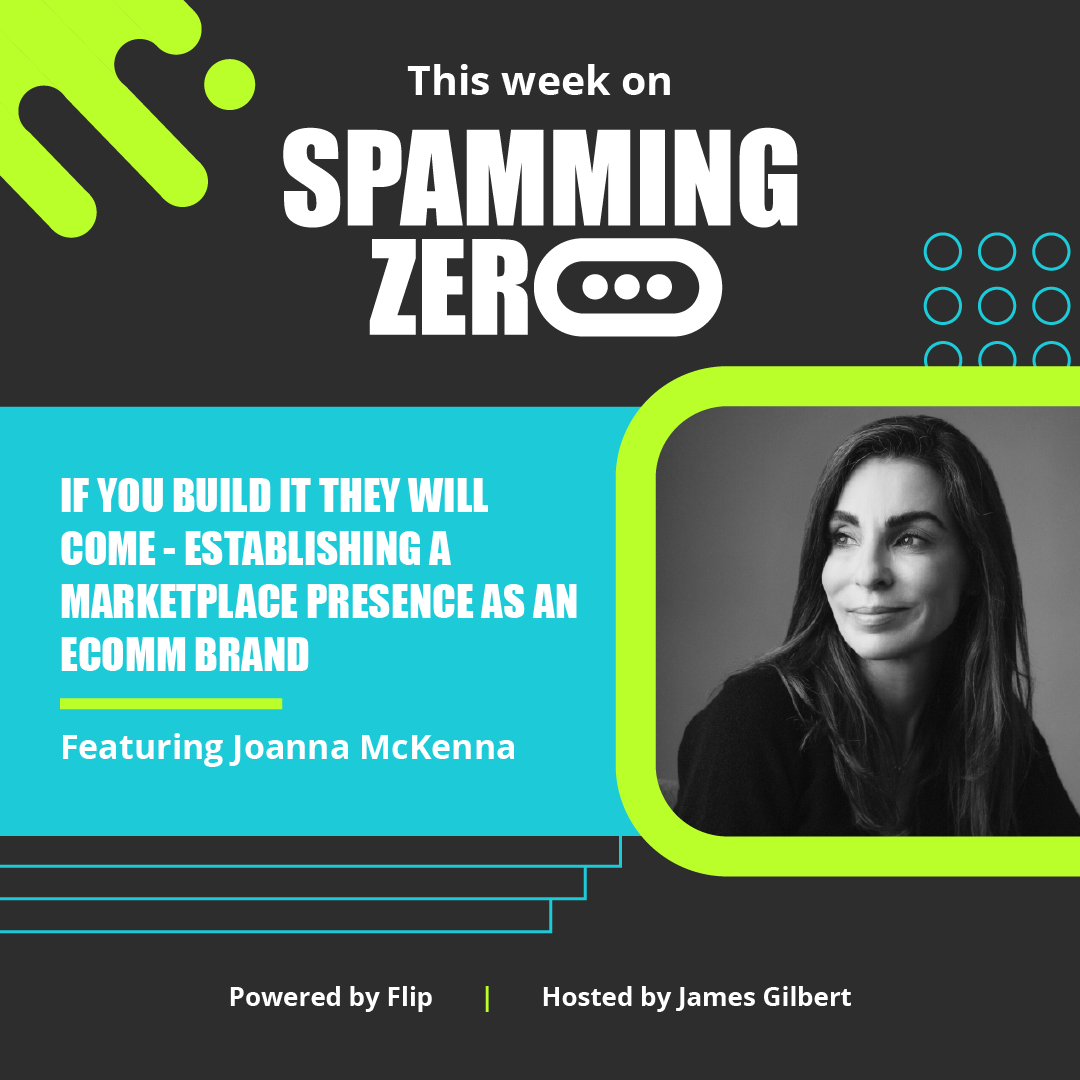Episode 63: Inside DREAMLABS - A Conversation With Blake Pinsker & Torii Rowe
- 0.5
- 1
- 1.25
- 1.5
- 1.75
- 2
Blake Pinsker: I'd have to say that it's rather easy to work in stride when you both have a data- driven mindset and you're both trying to reach the same desired outcome, because if it's data- driven, then you're driven by fact.
James Gilbert: I'm James.
Brian: And I'm Brian.
James Gilbert: And this is Spamming Zero. August 2023, this month's sponsor of the Spamming Zero podcast is Richpanel, richpanel. com. Go check them out. They do self- service automation at scale for eCommerce brands and direct to consumer brands. Some of their self- service models are order management, returns and exchanges. They have a branded help center, as well, agent handoff, custom workflows, and very soon subscriptions. We love Richpanel. They're one of our partners, as well. Here are some of their customers that use them, Finx, another one is SNOW, if you're familiar with SNOW, Brute Force, the Puppy Dogs Ice Cream company, lots of companies directly in the direct to consumer world. Also, they have a bunch of different resources for their customer testimonials, some of the integrations that they do directly on their website. I love some of the stuff that they do. They also have a pretty wide range of partners that they work with. So, if you're currently having a partner that has something in their stack and you're wondering if they integrate with it, they have a lot of that. But one of the biggest things that we get all the time is some of the order management. So, the self- service options there, like customer manage their orders. Customers don't need to raise a ticket to make edits to their Amazon order, change the shipping address, or they forget their coupon code. Give your customers the same experience on your website. That's what Richpanel does, self- service automation, richpanel. com. This is James Gilbert, your host. Super excited about this episode because we actually have two people on the show today. We have Torii Rowe. We have Blake Pinsker. Did I say your name right? I should have asked that before we started.
Blake Pinsker: Blake Pinsker.
James Gilbert: When we very first started the podcast, this is a true story, I was maybe a week into my role as a CMO, and I hadn't had a ton of interaction with our CEO, mostly because we were doing interviews and stuff like that, but I kept pronouncing his last name wrong. And we got on the first episode. Let me actually turn that into the trailer for the podcast Spamming Zero. But let's give a little quick intro. So, Blake, you led MVMT from 1 million to 100 million as the head of brand. He leads creative and growth of marketing industry called DREAMLABS. If you're not familiar with them, I highly recommend you check them out. Torii is also now at DREAMLABS, but before was a police officer and built, I believe the company is pronounced MANSSION.
Torii Rowe: Yeah, that is correct.
James Gilbert: Okay. And now, growing the company from seven figures to... in 14 months, so pretty impressive background for both of you. I want to dive into all of that. But before we do, we always start the show off with this question, if you had to get a tattoo of your favorite brand, tell me what it's going to be and why? Maybe you both have-
Torii Rowe: I'll kick this on. This is super easy for me, tatted up on both sides. So, I actually already have my brand tattooed on me multiple times. So, I have MANSSION tattooed on me. I have our logo up here on my shoulder, and then I also have our trademark, " Set Yourself Apart, on my forearm. So, super easy question and I've already done it.
James Gilbert: I like that. What about you, Blake?
Blake Pinsker: This one's pretty easy for me, too. I would go with something that is very close to home here in New York and also something that is very nostalgic and sentimental. Growing up, my dad was a huge Yankee fan and brainwashed all of us at a young age to watch every game. And I'd say a Yankee logo because it symbolizes family for me. It symbolizes winning. It symbolizes leadership. And so, that is a huge part of my background is growing up and watching sports and the Yankees winning all their World Series was a big part of that. So, I'd have to say it's the Yankees' logo.
James Gilbert: How are you feeling about the Yankees right now?
Blake Pinsker: They're trash. Yeah, Brian Cashman needs to get fired. They need a clean house. Keep Judge. And Cole is obviously, a beast, too, but this is the worst Yankees team I think I've watched.
James Gilbert: Oh, that's sad. See, I used to watch a lot of baseball. I don't as much anymore. I don't know why, but I really enjoyed the Steroid Era.
Blake Pinsker: Oh, yeah. I actually just bought a shirt on an Instagram ad that says, " Bring back Steroids," and its Sammy Sosa and Mark McGwire.
James Gilbert: I mean, was there ever a more exciting time in baseball than when those two were slugging it out and you were just trying to figure out who was going to break the home run record? I doubt it.
Blake Pinsker: That was the best. And pitchers were better back then, too. You think about Randy Johnson and Pedro Martinez-
James Gilbert: And Roger Clemens.
Blake Pinsker: ...and Roger Clemens. The pitching was also really good.
James Gilbert: It really was. Everything was better.
Blake Pinsker: Yeah, it was.
James Gilbert: Base runners ran faster. I think they should bring it back. I think Major League Baseball is way too strict on that stuff. Anyway, I digress. All right, let's dive into the topic. So, you both have created an amazing agency called DREAMLABS. Let's talk a little bit about that. What do you guys do? Who do you serve?
Blake Pinsker: Sure. So, I'll step in. We started DREAMLABS back in 2020. I left MVMT after we got acquired and decided that I wanted to rinse and repeat what we did at MVMT, take that D2C playbook and use it for other startups that were hitting a glass ceiling or struggling to get to that next level. What we focus on is where I feel is the most impactful piece of a D2C company scaling, which is performance marketing, mainly paid social and... so, media buying for paid social and creative for paid social, as well. Torii came on last year because he was the best media buyer that I had ever met and worked with, so I convinced him to partner at DREAMLABS, and since then, we've had a pretty incredible partnership growing insanely fast and all of our clients have been super stoked with how we are working together as a team now. Where Torii focuses mainly on the media buying side of the business, I focus on the creative. We do everything hand in hand, but we're both experts in those fortes.
James Gilbert: I love it. So, Torii, you got to tell me how did you go from police officer to being the best media buyer in the world?
Torii Rowe: In the world is a very broad term, but I'll take it. Yeah. So, following in dad's footsteps, started off as a police officer. I was in Phoenix, Arizona and stuff. It was a good time, enjoyed it. I worked a cool, fun beat when I was young. I wasn't like a traffic cop or anything. So, I had that competitive drive, took it over there, continued to do that, and then I was like, " All right, I can't do this for 35 years. I don't know how guys do it. God bless them." So, I ended up saying my best friend and I wanted to move to Denver and ended up starting MANSSION. So, MANSSION was a men's premium jewelry company. We needed someone to run ads, so we decided I would be that guy because we couldn't afford anything else, so ended up learning a bunch of advertising and stuff like that. Along the way, needed a new job, as well, so ended up picking up clients, figured out that I was pretty decent at it. And along the way, I met Blake. The story continues.
James Gilbert: I love it. I actually took a look at your guys' website. I think we had some people at your team that were actually checking us out, as well, because we were seeing you guys on our website, and so I did the same as normal marketers do when we stalk each other. That's what we do. And so, I took a look at your website and love the stuff you guys are doing. I'd love for you to talk a little bit about what's the biggest success story that you guys have had so far? Maybe you can mention the brand, maybe you can talk about, if it's okay to talk about, some of the metrics that they've seen. I'd love to talk about that for a sec.
Blake Pinsker: Sure. Yeah. Outside of Movement, I think our two biggest wins thus far are our clients. My Garden, which is an in- home hydroponic garden, and Kenny Flowers, which is a resort wear brand for men and women. Both those clients, we came on board and they were both hitting somewhat of a glass ceiling and struggling with efficiency. And we came in, took a new approach to both creative and also account structure. And thus far, we've seen incredible results to get them on track for their forecasts and their plans. And so, I think those are two of our biggest wins thus far. They're bigger companies, too. I can't share numbers, but they are substantial in size. And so, those are sometimes more challenging because brands hit a glass ceiling and can't figure out how to scale without sacrificing something, whether it's efficiency or other costs, as well. And so, coming on board, just take a good, hard look at the account structure and Torii did a great job fixing that and cleaning up the account, and then, also, creative and just getting back on track with creative that we know is going to convert in the account.
James Gilbert: What about you, Torii, what's your thoughts?
Torii Rowe: I would say the same. Those are those two clients that they were really hit those glass ceilings hard. It was one of those quick wins that continued to establish itself where we dropped CPA and got scale at the exact same time within 30 days. So, it was just like when you can do that in an account, especially with an account their size, well- established, like Blake said, it's a big win. There's a difference when you can be like, " Okay, we can scale this account." There's another difference when you're like, " Hey, we dropped your CPA by 50%, and now we're scaling you 50% month over month." That's a whole new ball game where they're like, " Okay, profitability is huge." One of them just opened a retail store for the first time, and I think a lot of that was already set, but I think that because of what we were able to do, sped up that timeline where they could make it happen faster inaudible profitability coming back.
James Gilbert: I love your tag team approach here because I think there's something to be said with Blake, you having more of the brand and the creative side, and Torii having more of the tactical execution on the paid side. Because as a CMO, I have so many things that I want to ask you just based on that, because I think that this is an area that gets really muddied quickly. You have founders and investors all the time that know the value of brand, but they don't know how to articulate it in such a way that it actually produces and becomes an outcome, and the content becomes an outcome in the tactical execution. So, how have you guys done that so well? What has been the difference maker?
Torii Rowe: Yeah. I would say the biggest thing is that Blake is an expert in brand creative and everything like that. And I have little but not a ton of knowledge in that area, and Blake has a good sense in grasp on paid media, but I'm the expert in paid media, so not this overlap. We'll give each other input on things, but we trust that the other one knows what we're talking about. The other thing is this, as Meta, Instagram, whatever you want to say, we continue to advertise. We know that creative is so important nowadays, and I think that's where a lot of agencies miss it. When you're outsourcing creative or you are outsourcing media buying, it's really hard for those to come together and be perfect. Blake and I spend a lot of time together. We're just in New York together and things like that. So, there's this communication that's almost unwritten at this point of we know what the other one needs. We know what the other one asks. It's a very simple thing of like, " Hey, I need iterations for X, Y, Z." He can go analyze that creative and understand what ads I need and vice versa. So, it's just when you're in- house and you have that communication super easy. We knock on wood, haven't had any major disagreements or anything on any accounts. It's usually just an unwritten rule that we know what the other one's doing.
James Gilbert: Anything to add Blake?
Blake Pinsker: Yeah. I'd have to say that it's rather easy to work in stride when you both have a data- driven mindset. You're both trying to reach the same desired outcome, because if it's data driven, then you're driven by fact rather than much of an opinion. And we both have opinions and ideas. And those who all get to play, we don't care at all whose idea wins, whether it's us or the client or someone on our team. We just want to get to that same desired outcome. We have that same objective. And then, both Torii and I, over the course of our career, spent combined over a billion dollars on Facebook ads. So, you see enough of these tests and you start to get a pretty good idea of what works and what doesn't. And you're also humbled a lot because oftentimes what you think is going to work, doesn't. And so, you're humbled real quick in this space. And I think both him and I have already been through that. We've gone through the years of trying to guess or arguing subjective opinions, and I think we're just over that. And so, it makes for a good marriage.
James Gilbert: I love that. So, every brand in the world right now is challenged with doing more with less. As a matter of fact, it's gotten to the point where I'm sick of hearing about it, and here I am talking about it, giving it more fuel, whatever. But it's true, everybody's being asked to do that. So, don't give me your total secret sauce here, but lay out the playbook. A client comes into you. We have to do more with less. Help us. What's your playbook?
Blake Pinsker: Yeah, I'd say it's easy when we start because there's often a lot of low- hanging fruit in an account from structure and creative, where like Torii said, he's able to drop CPA by 30, 40, 50% within 30, 60 days, which is significant. So, when we start, it's easy. Now, as we're going, we're running into problems now where top of funnel where growing extremely fast on an account, but the retention hasn't caught up yet. And so, you still need that even balance of retaining customers and acquiring new customers for the P& L to be healthy. And so, that's one of the challenges we're working through right now. And then, it is also in our best interest if we're helping those clients figure out how to improve retention, whether it's follow- ups, whether it's emails, SMS, some of these other channels. So, that's one of our big challenges now is once we scale top of funnel, how do we now make sure retention is dialed and working? Otherwise, you have to slow down what you're doing on the top of funnel side.
James Gilbert: I'm really glad you mentioned retention because that's the shift that's happened. You went from doing more with less, and that is the primary topic of discussion on almost every growth engine that I hear about, is well, let's focus on retention models. That being said, let's talk about how you guys approach that also on the paid media side, because this is, I think, a little bit of secret sauce that doesn't get talked about enough when it comes to paid media. See, most people that run paid media think that it is 100% an acquisition play and it is not. And Torii, I have no idea if you have good answers here, but I'm putting you on the spot. I'd love for you to talk about how you approach that from a paid media perspective with retention.
Torii Rowe: So, a lot of this depends on where they're at in business. Most of the clients we work with are quite large, minimum, usually$ 10 million a year, so just to set the stage here. So, most of them, we have a big retention pool to already pull from if we need to. So, it really depends where they're at in business, what we're trying to do. As far as a subscription model, it's going to be completely treated different from eCommerce. I do not go out and intentionally target retention or retargeting in any manner. Everyone talks broad, free audiences, all those things. I'm the exact same way. I don't put exclusions in unless there's this subscription model or some type of reason behind it. Everything else, I just let Facebook go do the targeting. We know that there's going to be retention inside that pool. We know there's going to be retargeting inside that pool. We know all of that is going to be in that free audience. But for me to go and say, " Hey, target, 180- day past customers or add to carts or whatever it may be, I'm not going to have that knowledge as good as Facebook." " It's been running here for years now. They know what they're doing." I leave that open. But like we said, we also know, too, from the Meta side, if you do go target retention, specifically, you can also burn your funnel very quickly. You can go burn through all of your past customers in three months and then the next nine months or next six months, however long that customer lifetime value turns over, your retention might drop off the face of the planet. So, there's this balance that you always need to keep between acquisition and retention. And like we said, if you see acquisition go too fast and retention doesn't catch up in time, then we see profitability because you're paying for more purchase and vice versa.
James Gilbert: I like the fact that you're not excluding them because I want to define this for the audience a little bit. If you're new to marketing or if you're not in marketing role, then this will help, make sense of it. So, what you just laid out, Torii, and the reason why you're not doing exclusions, to me, it boils down to really one big area, and that's that your customers, oftentimes... the retention issue is because you're not top of mind all the time, and so you got to be top of mind all the time. And by not having exclusions, the same customers that already have your products should still be seeing those same messages because they need to be top of mind. So, this is also an awareness play and it's important for our attention model to consistently be in the top of mind and in the share of mind of your customers and the potential customers that you're having. And so, just for the audience that's listening today, if you're not in marketing, that's why Torii doesn't do the exclusions. Am I accurate?
Torii Rowe: Yeah, 100%. I mean, a very simple example is Nike. Nike's new customer acquisition is probably very slim. I'm sure 5% of their customers every year are new customers. We've all probably bought from Nike at some point. But seeing the brand new shoes come out, seeing whatever's going by on the carousel ads and things like that, it might remind us like, " Hey, I do want a new pair of shoes, or I do want this." And it keeps, like you said, that brand awareness plate, it keeps them top of mind for us to say, " Hey, you know what, we're going to go back to Nike and buy X, Y, Z."
James Gilbert: So, Blake, this next question is for you. I think about brands that are growing really fast right now in eCommerce and D2C. One of them that come to mind is Liquid Death, obviously, I mean, come on. So, I think they've pretty much wrote the book and mastered the eCommerce brand play and growing it. Maybe not, you probably wrote the book, actually before them, but nonetheless, they're doing a great job at it right now. So, talk to us a little bit about what are the challenges that people are going to run into and how do they address that? Because I think every founder in eCommerce brand wants this growth engine from a brand perspective like Liquid Death. And let's be real, not everyone can do that.
Blake Pinsker: Yeah, I think Liquid Death has done a fantastic job. They're experts in viral marketing. They're experts in having a dialed and consistent brand voice and message. They're experts in creative ideas and coming up with new stuff that always makes you laugh or catches you off guard. And I know some of the people there and I think they're brilliant. They've done a fantastic job. The one thing I'll say about them is they have the playbook, but I wouldn't tell startups to look at them as what they should do, especially if they're bootstrapped and even if they've raised money. Because the problem is a lot of companies come along, and they haven't raised money, or even if they have, but they don't have the product. They don't have the same brand. And they can't produce the same work that they have and do it at the same scale. Like Liquid Death is a massive wholesale business. They're distributed everywhere. And so, you as a D2C company that's just starting up can't spend money like they do because it's a completely different business model, and they've raised a ton of money over the years that allows them to go spend on the crazy stuff that they do. So, I think you need to stay super focused and honed in on the people who are bootstrapped, the cuts clothings of the world, the movements of the world. What's another example, Torii, off top. Bootstrap, big company,
Torii Rowe: Bootstrap, big company. I mean MANSSION, I wouldn't say a big, but we're doing okay. But no, I agree with you 100%.
Blake Pinsker: Look at them for inspiration and ideas, but when it comes to playbook, you got to follow the bootstrap companies. And I see way too many companies, even if they raise money, they're just going out and spending money on the stupidest shit.
James Gilbert: It's true.
Blake Pinsker: More often than not, you're going to lose big when you do that. And Liquid Death is the exception to the rule.
James Gilbert: And that's why I brought them up because I wanted to clarify that for everyone on the show, that while I love them, they do insane, amazing stuff. Some stuff I have no idea how they get away with it, but you got to remember that if you're an eCommerce company, direct to consumer company, you do not have the same brand as them. You're not going to be able to do... you may not even have the same essence of your brand.
Blake Pinsker: We have people all the time send us their videos as inspiration for a shoot that costs... let's say they have a few thousand dollars budget and they're like, " We want to make this." There's no way, no human on this Earth would go through the hell of creating that type of ad for a few thousand dollars. That's just not how it works. Those are multimillion dollar shoots and videos, and campaigns. And so, it's a completely different model. It's completely different marketing mix, and you got to walk before you can run.
James Gilbert: So, what happens when you run into a founder, Blake, that doesn't get marketing, and that's generally what they think. " Hey, this should only cost a couple of grand. Come on, let's do it. Why the heck can't you do this?" What do you tell them?
Blake Pinsker: No, straight up. It doesn't happen all that often, but when it does, of course, I try to educate them on where they should be looking and why this doesn't make sense. Some of them walk away and then they go try to find somebody who can make that for a few thousand dollars. And once they realize that nobody on this planet will, then they'll typically come back and say, " Hey, I learned a valuable lesson. We blew a ton of money last year. How do we fix this?"
Torii Rowe: Yeah. I think we more run into people, honestly, thinking that marketing is going to fix all their problems, too. Whether that's creative or advertise, yeah, I wish, I wish, because I would be on a yacht right now. No. People come in and they're like, " Hey, listen, our EBITDAs minus 25% for the last year, it's our Facebook ads. Can you fix it?" And it's like, " No, it's your business model. Your business model is dog shit. You can't scale it." I mean, honestly, let's look at Liquid Death. Shout out, Liquid Death, but what a dumb business model, the worst business model you could have ever thought of like, " Hey, let's sell water, nothing proprietary, super heavy. Let's ship it straight to the consumer online." What a terrible idea. And somehow they've made it into a billion- dollar company, that just tells you how great their team is. But it's insane to think that you're just going to ship water across the country and make-
James Gilbert: Well, It's a really strong message, death to plastic, it's behind a cause, number two, and then number three, it's creating the virality moments, which is why they have the Murder Your Thirst and being different. So, I think the combination of those three can certainly have an aspect in almost any brand. We actually try to do that. I think we do it fairly okay at Flip, but it's tough to do, I think, much tougher to do, by the way, in a B2C company, much tougher for my own personal.
Torii Rowe: Absolutely.
Blake Pinsker: For sure. Liquid Death, I don't know, their sales, but I'm almost certain it's probably anywhere from 80 to 95% through grocery chains and 7- Elevens, and wholesale.
James Gilbert: Yep, I believe that. My daughter, this is a true story I got to tell you because now we're on this topic, it just has me, reminded me of it. My daughter went to a concert with my wife. They went to Fall Out Boy. And so, they were selling Liquid Death. And my daughter's like, " Oh, I want this. It looks so cool." So, she buys the can. And you never keep a can ever, but she kept the can. So, she brings it home, puts it in her room. My daughter's 14, almost 15. And my 11- year- old son, she went and saw her dad. My 11- year- old son goes in a room and finds the can. And he comes down and he's like, " Mom, dad, I have some bad news. I found this in Reagan's room and I am pretty sure she's drinking. My 11- year- old son thought it was a beer can.
Torii Rowe: This is going to turn the new UGC content for Liquid Death by next week.
Blake Pinsker: I think that there's a bigger problem. I think you got to tell your son not to snitch on his sister.
James Gilbert: I mean, yeah, absolutely true. But it became this topic of conversation because you're right, at the end of the day, it's just water. And we literally showed him the ingredients and like, " See it's just water." And he's like, " Oh, weird."
Blake Pinsker: Yeah, right. That's pretty funny.
James Gilbert: So, there are obviously challenges that I think every brand can run into today, and you guys help solve a lot of those challenges, especially from a growth and an acquisition perspective. But I'd love for you both to talk about what have been your biggest learnings in working with this industry, just in general, what are your big learnings and what are your big takeaways?
Torii Rowe: I would say biggest learnings is like what Blake hit on earlier is you got to trust the data. It's so hard as a marketer or a creative expert to come in and be like, " Hey, I really like this creative and it looks so good and it's going to work." And I'm not going to lie, half the time I think that it doesn't work at all, literally the worst CPA. And I'm like, " I want to run it." Especially for my own brand, it's hard for me to step away from MANSSION sometimes because I'm like, " This looks so cool." Like Blake said earlier, it's very humbling over and over, especially Blake running MVMT, me, still on MANSSION, and things like that. You have to figure out to know what you don't know. You have to step back and be like, " Okay, I don't know this. I don't know what's going to work or whatever it may be." And be like, " Okay, just trust the data. Let it lead us in the right direction." You think you know more than you probably do, and then something ends up. Even price points or landing pages, all of that stuff, it's very humbling what ends up working.
Blake Pinsker: I could probably sit here for another hour and talk about learning lessons since I already talked about being data- driven, which is probably my greatest lesson in eCommerce. I'd say the second, I'm going to go in a different direction, and I know a lot of startups have this problem. But I think a major key for you and your future and growing the company is make sure you're hiring winners that bring incremental revenue to the business early and fire toxic employees.
James Gilbert: That's a mic drop right there because it's true, especially at startups, the biggest adherent to growth is not making hiring decisions or firing decisions quick enough by far.
Blake Pinsker: Yeah. I think people hire the wrong positions too soon. They hire positions that aren't making a huge impact on the growth of the business, which is a problem. And so, oftentimes a few years in, people will have 10 to 15 employees realizing they don't need half of them. And I think that was one of our big learning lessons post- COVID era and especially in this economy today where investors and potential acquirers are valuing profit over top line. And so, I think you really need to take a good hard look on how you're building your team, strategically hiring people that are going to help you bring incremental revenue to the business. And then, two, even if you have an A player and they're toxic, and they kill the culture and nobody likes working with them and they make everybody's life miserable every day, and they just don't play as a team, you got to cut them, too. Because I believe in every organization you have good eggs and you have people in the middle that could be swayed one way or the other. And when you allow bad eggs to stick in the company, oftentimes those people in the middle that can be influenced are swayed to the bad side, which ultimately can teeter and destroy a culture. And so, I've seen that time and time again in this space and just in the business world. And ultimately, you want to reward your A players with a great culture and a great team environment where everybody has the same mission. Everybody supports each other. Everyone's got each other's back. And there's not somebody who's making everybody's life hell every day because they're just so difficult to work with.
James Gilbert: Yeah, I love that. One of my favorite quotes to measure your leadership style is this, " The measurement of your team's morale is the outcome of your leadership style." And I love that because you as a leader can do one of two things, inspire and motivate or derail and it goes downhill. Be negative or be optimistic. And I think naturally, when you're, especially, in a startup, there are ups and downs all over the place. And how you manage the good, the bad, and the ugly is super important. And I love you put this out here, Blake, because I do 100% agree with you. You cannot afford for the toxicity to be there. And you cannot afford for it to have influence on others because that can derail your growth engine faster than anything. For sure, I totally agree with you on that. Okay. We're going to do something that I wasn't planning on doing. But I'm going to ask it just because you've got me thinking about it a lot. Brand and growth together and what you guys do at DREAMLABS, I'm curious how is AI having an impact on some of the things you guys are doing and how are you leveraging it?
Blake Pinsker: Yep. I think we'll both have a response on this, but I'll start by saying that we're using it actively to help us copyright on the creative side. So, whether it be scripts or copy or hooks, it's allowing us to generate hundreds of different copy points for us to look through. And that ultimately is having a huge team of copywriters working for you in a split second. So, that's huge. We've also experimented with stuff on the animation side where we're turning still images into an animation or a video, which is really cool. And some of those have done solid considering it's very new technology. And I do see AI going to a place where it's not long before we just hand over a bunch of raw footage and it just edits an entire video for us based off whatever feedback or prompting we give it. So, I certainly think it's going to be a huge part of what we're doing. And I'll let Torii jump in. I know he's using it a lot, as well.
Torii Rowe: Yeah. I mean, depending on the platform. AI is already existing in some of the platforms itself, like what will happen, but outside of the social platforms and stuff like that we're advertising on or Google whatever. I also use it to do a lot of data, so uploading data into it, having it graph things, so exporting from Facebook or whatever, having it graph things in a certain way, seeing if there's a correlation, asking if there's a correlation between the two. And you got to take everything with a grain of salt, as we know it's still in a learning process. It's probably already surpassed my smarts on a lot of things. And so, I just ask it a lot of questions. I'll put data in there that maybe I couldn't put a direct correlation between the two. Or for example, a really good one is Meta coming out with the attribution windows recently where you can view one day, seven- day, and 28- day all on the platform. So, exporting those and then seeing what the correlation is between what our Shopify data says or whatever compared to maybe our ESP, as well. So, are things getting cleaned up in Klaviyo on a 28- day period from the first touch point? And that's why we see attribution lifts in Meta or things like that. So, for me, it's just a lot of data, but that's where I live, in general. So, things like that. But also, like Blake said, I think the biggest win for us so far is the creative headline testing. We do a lot of headline testing, trying to figure out what's going to really hit, and it's very hard to think of 10 headlines sometimes for a brand. AI can spit out 150 of them within a couple minutes, and it's pretty nice to use.
James Gilbert: I keep saying... so, I even did a post on this today on LinkedIn, the number one thing that's talked about over the last 12 months and every single conversation that I've had with people in eCommerce direct to consumer CPG brands without provoking it, I provoked it with you guys, but without provoking it, AI is mentioned in some form. And I think the definition of AI is confusing the people. Well, let me clarify. I think the definition of AI needs to be clarified more. There's AI, which you alluded to, Torii, which is directly in some of the tools that we use and some of the things that we use. But then, there's what Blake mentioned, which is actually a different definition of AI. That's more generative AI, and that's the boom that's happened over the last six months. And I think generally speaking, all of us have to talk about that in those two forms because there are so many businesses that are still trying to figure this out, especially in eCommerce. We're an AI company at Flip, and we do generative AI, and so it's one of those things where we run into this all the time. People are like, " Well, we're exploring AI, and we really want to know how it can help our business and be more efficient." And we're like, " Well, actually, you're probably already using AI. But what you're probably not doing is more of the generative AI stuff, which is having it be almost like a brainchild at your organization and creating new things for you. And I think that's the big differentiator that we have to keep making in the market. We're going to shift gears and go to our favorite segment. We're going to play little game called FMK. We'll start with Torii and then we'll go Blake. Torii, what's sexy right now? What's around and here to stay? What do you want to kill like yesterday?
Torii Rowe: I mean, for sure, probably the sexiest thing is AI. But to give a different answer on that, I'd probably say consolidation in Meta. I think that's a very big thing right now that's really sexy, starting to get talked about a lot, as far as the marketing side of things, which is so stupid. But the old school mindset of using interest- based audiences and have these massive campaigns and trying to target on your own and stuff like consolidation is sexy. What's here to stay? I mean, same thing. I would say Meta's here to stay. I feel like a lot of people are having conversations about it and whether it's going to last and things like that. It's not going anywhere, anytime soon. That's here to stay for a long time. I'd probably say the next 50 years, it's still going to probably be the number one tool for advertisers across the platform. It's not leaving. You can take TikTok and kill that shit like yesterday. I'm still sick of that shit. TikTok is cool, whatever. But I'm good on that. And you know what's funny is I advertise it on it still, but it's like, listen, you're talking, I don't know how many years old now, four, maybe five years old company, maybe longer, and I'm just naive. But you think this is going to catch up to Meta in any type of fashion or facet. You know what, kill that thing. Get China out of here. Let's move forward. We don't need that shit here. I'm going to stick with Meta.
James Gilbert: I love it. Blake, what do you got for me?
Blake Pinsker: Torii, definitely still would kill. I was thinking TikTok because I also just personally don't think the platform is for me.
James Gilbert: And it's not very safe.
Blake Pinsker: Yeah. And I don't have kids yet, but there's no chance I'd want my kids on that platform.
James Gilbert: I have four and they aren't allowed.
Blake Pinsker: Smart, smart man. Yeah, I've seen it brainwashed, not brainwashed, but influenced my friends who are adults. Now, imagine a kid's brain using that platform for 30 minutes, an hour, two hours, three hours a day. What I do think is here to stay is the creator economy. I think we're moving more and more towards a world where you're going to have solopreneurs in small businesses on the back of the creator economy, and I'm interested to see how that plays out. I think the less and less content will be consumed on TV. And so, even Netflix, I think Netflix could be screwed long- term because that content is being commoditized everywhere.
James Gilbert: We're going to see in five years if Blake is a prophet right here. We're going to tag this and see if in five years Blake has prophetic ability.
Blake Pinsker: True. But yeah, I think the creator economy is here to stay. What is the other one, F?
James Gilbert: What's sexy right now?
Blake Pinsker: Sexy, what do I want to flirt with, w e could say.
James Gilbert: It actually stands for the F- word, but my daughter listens to this show and she called me out at the dinner table because I was swearing a bunch, and so now I'm trying to be a cleaner dad.
Blake Pinsker: Yeah, of course. No, I know it stands for the F- word, but I'm going to say flirt. I want to flirt with... I want to see what this Shopify AI tool is all about when they drop it.
James Gilbert: The shop at AI?
Blake Pinsker: No, it's called... I'm blanking on the name. Toby announced it Shopify AI tool, Sidekick. Yeah. What the hype video said was that this tool is going to scrape your site and analyze what's happening on your site, so you could find massive drop- offs and reasons why things aren't converting. You could ask it questions. So, let's say all of a sudden, you have a huge drop- off in conversion. Apparently, you'll be able to ask the Sidekick, " Hey, what's going on with our site? Why do we have a massive drop- off in conversion?" If that tool works, that could be so valuable for eCommerce stores because when you go through those challenges, you could spend weeks or months searching and trying to figure out what the hell is happening, which is valuable time to lose 20, 30% on your conversion rate. And so, I think that could be an extremely flirtatious tool in the market.
James Gilbert: Not to steal Shopify's thunder, but you need to check out Justuno, because Justuno has been around a little while now, and they've been doing that exact thing for a while using generative AI and AI to do it. So, it's interesting that you bring that up. I didn't know about Sidekick being announced, but Justuno is another one you could check out.
Blake Pinsker: So, I know Justuno, they do pop- ups and whatnot. Do they actually give you live critique on conversion drop- offs?
James Gilbert: Yeah, they do the full CRO.
Blake Pinsker: Interesting.
Torii Rowe: Come a long way. I mean, I would guess Shopify, I would hope. Justuno I used to use. They're a solid company. I would guess Shopify's is going to be hopefully light years better.
James Gilbert: They have way more resources.
Torii Rowe: The other thing, too, is the upsides. Justuno is doing it to make more money as far as subscription model or whatever that looks like. Every order that processes through Shopify, they're getting a credit card processing fee. So, their upside is exponential if this tool works. If they get 30% more orders through, they're going to be-
James Gilbert: That's a really good point. I didn't even think about that.
Torii Rowe: That's all they are. That's how Shopify makes all their money. I mean, they're not making money on the subscription. They're a giant credit card or merchant processing company, 2. 9% plus 30 cents. That's where they're making their bread.
Blake Pinsker: And I'd say Shopify is actually my other Mary along with what we've already dropped. Because Shopify sounds horrible, but they are a monopoly and they're the platform that everyone should be using in the space, unless there's some crazy customization reason why you can't use Shopify, which if that's the case, good luck building.
Torii Rowe: Yeah, you can kill WooCommerce while your attitude.
Blake Pinsker: Everyone should be on Shopify.
James Gilbert: I love it. Let's keep this fire going. Yeah.
Torii Rowe: You lit a fire under our, James, and now we're sitting here like we're going to come at some brands right now.
James Gilbert: I love it.
Blake Pinsker: I'm killing TikTok, too.
James Gilbert: Let's do it together.
Blake Pinsker: And Threads.
James Gilbert: Oh, yeah, and Snapchat. Those are the three that I'm like-
Torii Rowe: Irrelevant.
James Gilbert: ...they can go like yesterdays. Gentlemen, we're at time. What is your parting remark for all those that listen?
Torii Rowe: That's a good one. I mean, if you want to take your company from eight figures to nine figures, come check us out at DREAMLABS. That'd be my parting remarks. And keep learning, keep learning. Get off TikTok and ask questions. I would say that's the big one. Continue to ask questions. Continue to learn. That's how you really level up in this game. What takes you from seven to eight? Is it going to take you to eight to nine? And people who have already done it, they're going to have that knowledge. You should ask them.
Blake Pinsker: Yeah, I'll leave you with a quote that was our favorite quote at MVMT and it said, " What got us here won't get us there." Meaning what got you to step one will get you to step two and step three. And so, you constantly have to reinvent yourself. You constantly have to reevaluate where you're at. Stay humble, and yeah, that's what I will leave you with.
Torii Rowe: I got one more or two, James. Let's go Phoenix Suns not the Utah Jazz. There we go.
James Gilbert: We stand no chance, and I'm okay with that. We had our chance with Michael Jordan, and I'm not going to get into that because we could go another 40 minutes. But listen, I'm rooting for you. I root for the Suns. I was actually happy to see Denver win the championship. I thought that was pretty cool. I want these small market teams to start taking back the league.
Torii Rowe: Don't worry, I'll be disappointed again in the Western conference finals. I have no doubt about it.
James Gilbert: All right, well it's been awesome, guys. Thank you so much for joining the show today. And again, every week you're going to get different episodes just like this with people that are amazing, like Torii and Blake. So, come check us out, Spamming Zero.
Blake Pinsker: Thanks James.
Torii Rowe: Thanks.
DESCRIPTION
This week’s ep is all about branding. And, right now there’s no 2 better brains to pick on the subject than Blake Pinsker & Torii Rowe - the power partnership behind DREAMLABS. Take in their top tips - this week, on Flip CX's Spamming Zero podcast.
What’s Covered?
- The power of a data-driven partnership
- A peek into DREAMLABS’ playbook
- Helping brands do more with less
- AI: The new age copywriter and animator
- The larger impact of AI on creative processes
- Shopify's sidekick: A game-changer for E-Commerce?
- And a whole lot more
Ready for more fantastic Spamming Zero conversations ahead? Listen, rate, and subscribe on YouTube, Casted, Apple Podcast, or Google podcasts.
Today's Host
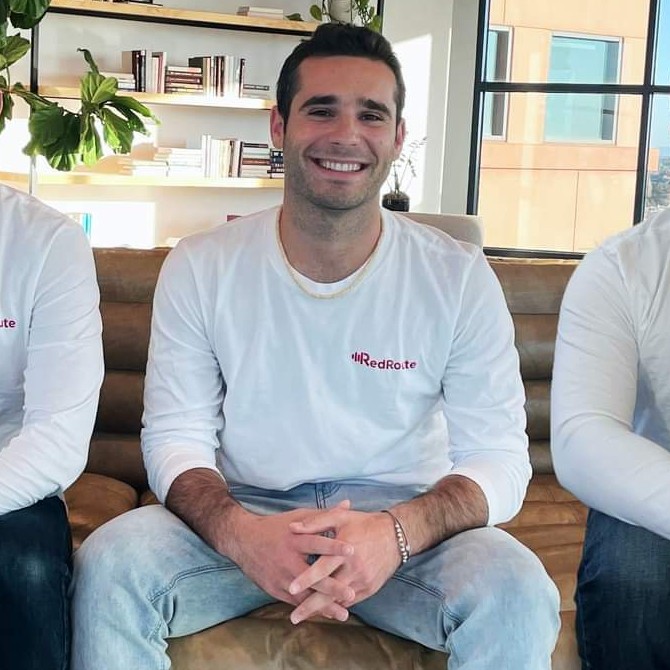
Brian Schiff
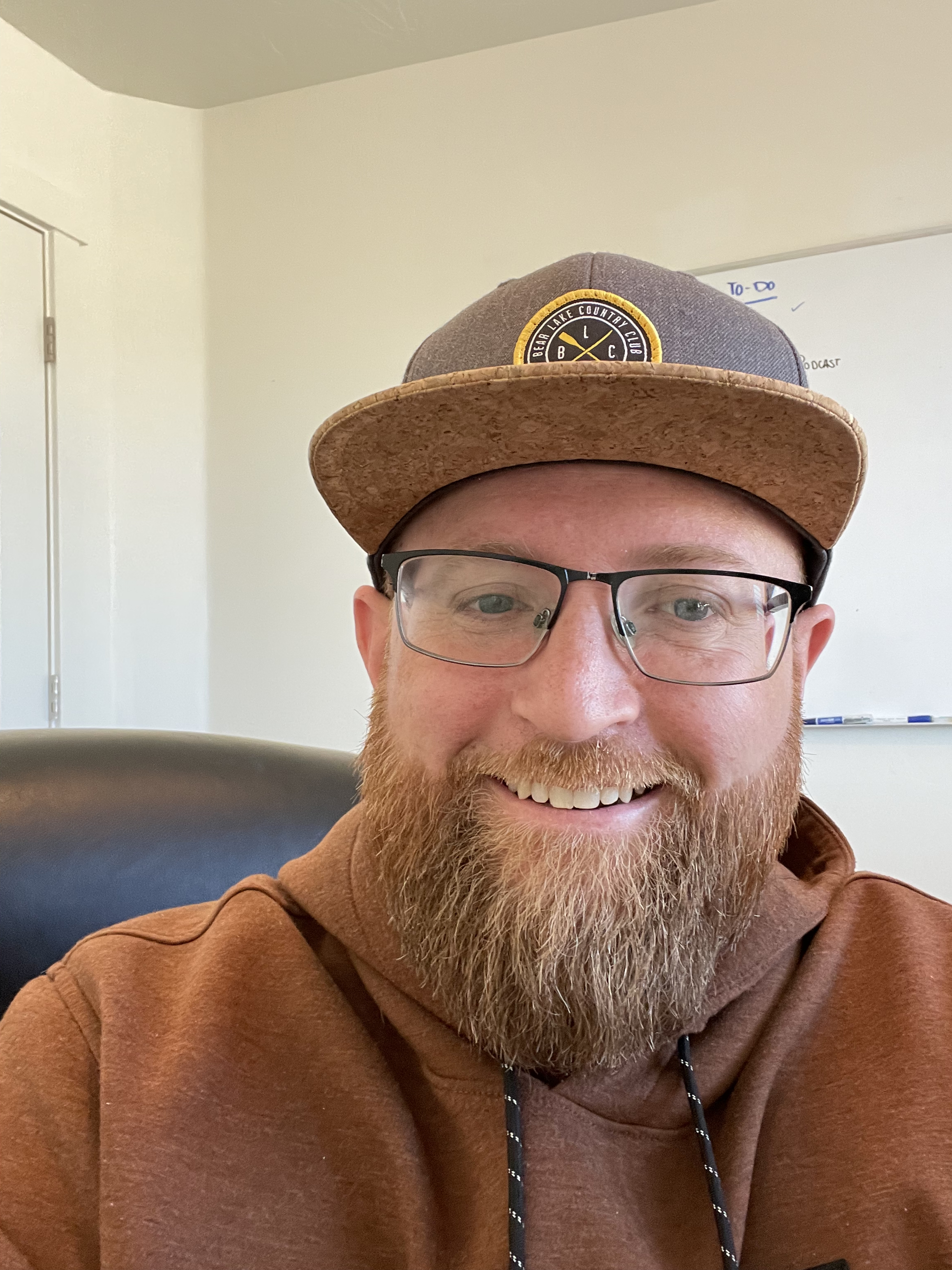
James Gilbert
Today's Guests
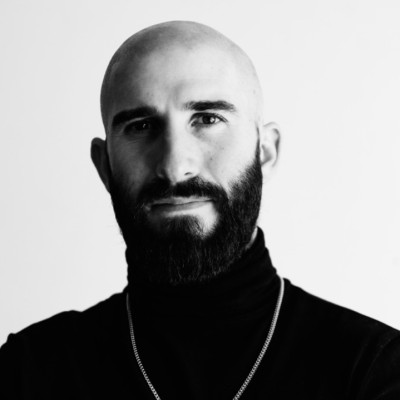
Blake Pinsker
